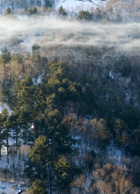Wood Smoke: Press Release
Environment and Human Health, Inc.’s (EHHI) report, The
Dangers from Outdoor Wood Furnaces, shows that current regulations for
outdoor wood furnaces (OWFs) are not sufficient to protect human health. Wood smoke contains many of the same toxic compounds that are found in cigarette
smoke. Just a few of them include benzene, formaldehyde, and 1,3-butadiene, all
three of which are carcinogenic. Currently, some states have OWF “set-back” regulations of 100 feet, others
have “set-backs” of 200 feet and some states have no regulations at
all. EHHI measured two particle sizes found by EPA to be contained in wood smoke and
designated to be the most dangerous to human health. These particles are PM 2.5 and PM
0.5. The study showed that a house 100 feet from an OWF had 14 times the levels of PM 2.5 as
houses not near an outdoor wood furnace and 9 times the levels of the EPA air
standards. A house 120 feet from an OWF had over 8 times the levels of PM 2.5 as the houses not near
an outdoor wood furnace, and 6 times the levels of the EPA air standards. A house 240 feet from OWF had 12 times the levels of PM 2.5 as the houses not near an
outdoor wood furnace and 8 times the levels of the EPA air standards. And a house as far away as 850 feet from OWF had 6 times the levels of PM 2.5 as the
houses not near an outdoor wood furnace and 4 times the levels of the EPA air
standards. High levels were present in every 24-hour period tested inside homes neighboring outdoor
wood furnaces. All houses tested had particulate exposures well above the EPA ambient
air quality standard. Levels of PM 2.5 that exceed the EPA standards are associated with
asthma or chronic obstructive pulmonary disease (COPD) attacks and hospitalizations, and
are also associated with increased risk of cardiac attacks. Particles of wood smoke are so small that windows and doors cannot keep smoke out. A
study by the University of Washington, Seattle, showed that 50 to 70 percent of outdoor
wood smoke entered homes that were not burning wood. Because wood smoke particles are so small, they are not filtered out by the nose or the
upper respiratory system. Instead, these small particles end up deep in the lungs where
they can cause structural damage and chemical changes. Carcinogenic chemicals and wood
smoke irritants adhere to the small particles and enter the deep, sensitive regions of
the lungs where toxic injury is high. Public Health Toxicologist David Brown, Sc.D., an expert in wood smoke, says, “Some
of the health effects reported to EHHI include awakening at night with coughing,
headaches, inability to catch breath, continual sore throats, bronchitis and colds
requiring children to stay home from school. In some cases the breathing difficulty has
gone into asthma attacks requiring emergency-room treatment. Even episodes of short-term
exposures to extreme levels of fine particulates from wood smoke and other sources, for
periods as short as two hours, can produce significant adverse health
effects.” Oncologist D. Barry Boyd, MD, says, "In addition to the fine particulate matter,
wood smoke contains a number of organic compounds that are potential or recognized
carcinogens. Exposure over time may raise the risk not only of chronic lung disease but
also of lung cancer. As well, wood smoke interferes with normal lung development in
infants and children. It increases children's risk of lower respiratory infections such
as bronchitis and pneumonia. Wood smoke exposure can depress the immune system and
damage the layer of cells in the lungs that protect and cleanse the airways." Outdoor wood furnaces create emissions different from either fireplaces or indoor wood
stoves. The Northeast States for Coordinated Air Use Management (NESCAUM) found that the
average fine particle emissions from one OWF are equivalent to the emissions from 22
EPA-certified indoor wood stoves, 205 oil furnaces or as many as 8,000 natural gas
furnaces. The short-term health effects of wood smoke exposures are burning eyes and throat,
sinusitis, bronchitis and pneumonia. The long-term health effects are asthma, COPD, cancer, cardiovascular problems and carbon
monoxide poisoning. Dawn Mays-Hardy of the American Lung Association, New England, says, "Because
wood smoke has many of the same components as cigarette smoke, and because wood smoke
emissions from outdoor wood furnaces are so thick and pervasive for all those who live
near them, American Lung sees them as dangerous to health.” President of Environment and Human Health, Inc. Nancy Alderman says, "EHHI has now
shown that wood smoke from outdoor wood furnaces enters neighboring houses in high
enough amounts to cause serious health impacts to these families. States can no longer
ignore this science and should ban outdoor wood furnaces until safer technologies are
found.”
